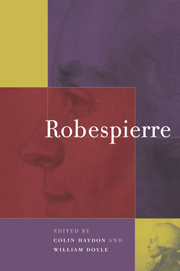Book contents
- Frontmatter
- Contents
- List of contributors
- Acknowledgements
- List of abbreviations
- Part I Introduction
- Part II Robespierre's outlook
- Part III Robespierre's politics
- 7 Robespierre and the press
- 8 Robespierre, the war and its organisation
- 9 Robespierre and the insurrection of 31 May–2 June 1793
- 10 Robespierre and the Terror
- Part IV Robespierre in retrospect
- Part V Conclusion
- Index
7 - Robespierre and the press
Published online by Cambridge University Press: 14 January 2010
- Frontmatter
- Contents
- List of contributors
- Acknowledgements
- List of abbreviations
- Part I Introduction
- Part II Robespierre's outlook
- Part III Robespierre's politics
- 7 Robespierre and the press
- 8 Robespierre, the war and its organisation
- 9 Robespierre and the insurrection of 31 May–2 June 1793
- 10 Robespierre and the Terror
- Part IV Robespierre in retrospect
- Part V Conclusion
- Index
Summary
Robespierre was a journalist for less than a year of his political career. Unlike Brissot or Carra, who moved effortlessly from the world of pre-revolutionary letters into the maelstrom of journalism and national politics, he only published his first newspaper when his political reputation was already well known. Unlike fellow deputies in the Constituent Assembly such as Mirabeau and Barere, who launched newspapers in the summer of 1789 to maintain contact with their constituents and create a national profile, he only followed them when he was no longer a deputy and his profile was already well established. As in so many other ways, Robespierre was different. Journalism for him was a means rather than an end, something which he used to support his political career when under attack in the spring of 1792 and abandoned shortly before joining the Committee of Public Safety in the summer of 1793. Yet although only a transitory journalist he owed some of his reputation to the press and had a healthy respect for its role in the new political world that the Revolution created. As both politician and journalist he held strong views on press freedom and the journalist's political function which were formed while he was out of power, then modified and enforced while he was in.
When elected to the Estates General in the spring of 1789, Robespierre already had some contact with journalism, for he and his sister Charlotte were on friendly terms with Madame Marchand, the owner and editor of the Affiches d'Artois in their home town of Arras.
- Type
- Chapter
- Information
- Robespierre , pp. 111 - 126Publisher: Cambridge University PressPrint publication year: 1999



